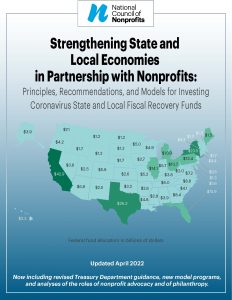This article is re-printed with permission from National Council of Nonprofits. Thank you!
Plus, check out Common Good Vermont’s Nonprofit Resource Guide for Local ARPA Funds!
UPDATED REPORT: Strengthening State and Local Economies in Partnership with Nonprofits
By the end of May, all 50 states and the District of Columbia will have received their full allotment of funds from the American Rescue Plan Act’s Coronavirus State and Local Fiscal Recovery Funds program. Yet few, if any, states have determined how they will spend all of their allocations. Likewise, county, city, and Tribal governments need to decide how they will use the funds they receive.
The networks of the National Council of Nonprofits have revised and expanded the earlier edition of Strengthening State and Local Economies in Partnership with Nonprofits to provide the latest federal guidance and fresh examples from across the country. This resource can serve as a guide for governments, charitable nonprofits, and foundations on investing these funds – totaling $350 billion – to help communities respond, adapt, and recover from the COVID-19 pandemic.
The updated and expanded edition of the Special Report recognizes that while nonprofits are eligible for Coronavirus State and Local Fiscal Recovery Funds (CSLFRF) resources, they are not automatically entitled to receive any funds. Governments have multiple options, and they are weighing many competing requests for the funds.
In this Special Report, readers will find:
- An up-to-date analysis of the federal rules governing the spending of these important resources, with an emphasis on clear guidelines on investing in charitable nonprofits.
- Guiding principles and proven recommendations for designing programs with impact.
- More than 60 examples of successful programs through which governments have invested ARPA Coronavirus State and Local Fiscal Recover Funds in and through charitable nonprofits to address pandemic-related challenges as well as longstanding problems exacerbated by the pandemic.
- The role of nonprofit advocacy in making the case for why investing in charitable organizations is the best use of a government’s allocation.
- Insights on the numerous ways foundations have been helping their grantees and communities approach and implement the CSLFRF program.
- A breakdown of how much in CSLFRF state governments have received and will be receiving in the coming months.
- Extensive resources from the federal government, the National Council of Nonprofits, and many other sources.
Read the Executive Summary, the full report, and the User’s Guide.
The federal government showed tremendous trust that governments closest to the people and their problems are best positioned to decide the best ways to spend their allocated resources to meet local needs. Now state and local governments, charitable nonprofits, foundations, and the public need to honor that trust by working together to make informed, equitable decisions and implement successful programs.
Did You Know?
The Treasury Department did nonprofits a great service by completely rewriting its CSLFRF guidance to make it abundantly clear that charitable organizations are eligible for funds and that needless procurement obstacles are not required.
- Governments have the express authority to use their CSLFRF allocations on charitable nonprofits in two distinct ways: (1) to provide direct assistance to nonprofits as beneficiaries trying to recover from the pandemic’s impact on their organizations, and (2) to hire nonprofits as providers of services to others on behalf of those governments.
- Governments may make advance payments to nonprofit subrecipients; officials are not required to insist on service first and reimbursement later. See Governments Can Use ARPA Funds to Partner with Nonprofits in Two Broad Ways.
The Role of Nonprofit Advocacy
“Where do we apply for ARPA funds?” That’s often the first question nonprofits ask when they learn of the availability of ARPA’s Coronavirus State and Local Fiscal Recovery Funds. But due to the unique nature of this one-time funding stream, the response typically must be, “Nowhere, unless we as nonprofits advocate with our state and local governments for effective programs that include charitable nonprofits.” Nonprofits cannot politely sit silently, expecting government officials to remember all the enormous work nonprofits did to hold communities together throughout the worst of the pandemic. Learn more about The Role of Nonprofit Advocacy.
The Roles for Philanthropy
This expanded edition of the Special Report includes a new section highlighting numerous ways foundations have been helping their grantees and communities approach and implement the CSLFRF program. It presents examples in three broad categories of foundation actions:
- Using their own resources in creative ways, ranging from direct financial support, like matching grants, to indirect support in the form of capacity building grants that can promote equity and inclusion now and in the future;
- Providing their grantmaking expertise to help distribute and administer the ARPA funds to nonprofits in their communities; and
- Convening groups to build relationships and advance and collect ideas about how the ARPA funds can be used to address local challenges. Learn more about The Roles for Philanthropy.
What the States Are Receiving, When
State, local, Tribal, and territorial governments must obligate (commit to how they plan to spend) their specific allocations of the CSLFRF funds by the end of 2024 and spend them by the end of 2026. Many are making decisions rapidly; others are gathering information. CSLFRF funds were distributed in 2021 based on unemployment rates in the states. Twenty states and the District of Columbia received their full allocation last year due to higher unemployment rates (defined as 2.0 percentage points or more above its pre-pandemic level). The other thirty states received half of their allocation last year and are scheduled to receive the second equal tranche in May 2022. See the chart, Federal Allocations per State.
Read the Executive Summary, the full report, and the User’s Guide. And check back regularly for updated resources and other information.


